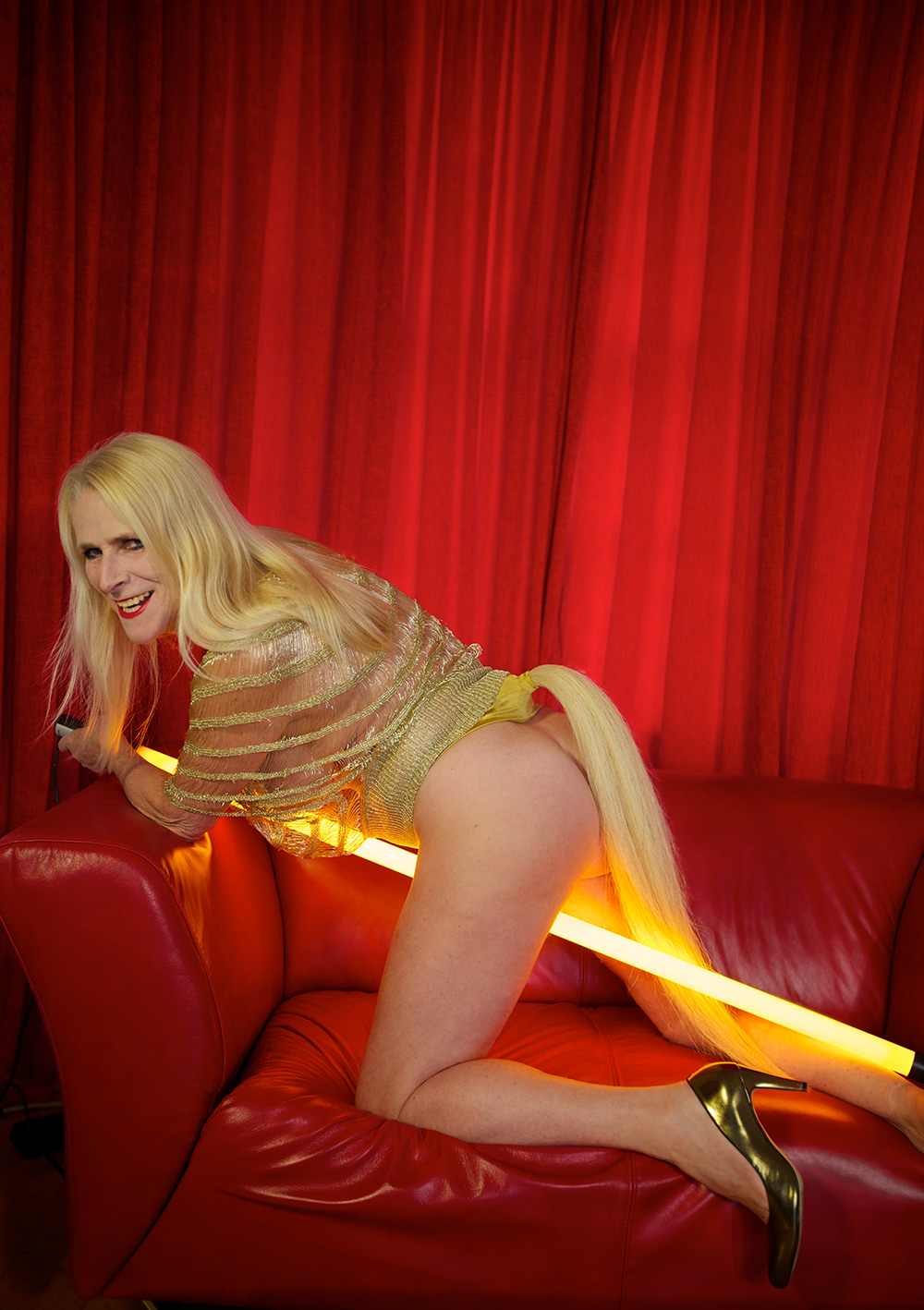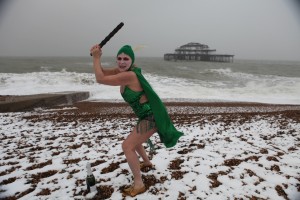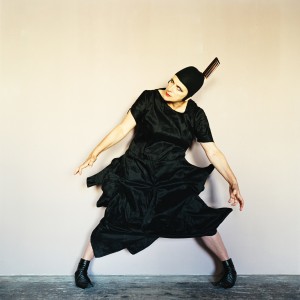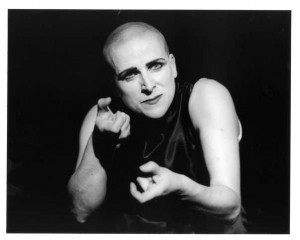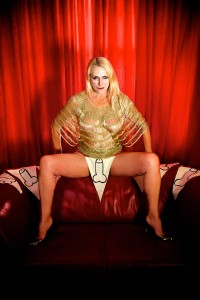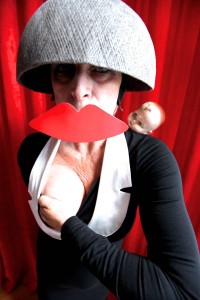Dorothy Max Prior encounters the force that is Liz Aggiss, whose show Slap and Tickle comes to the Edinburgh Fringe 2017 as part of the British Council Showcase.
‘I stage a revolt against the mundane and banal through the re-appropriation of glamour and beauty. I am a one-woman operation; performing, directing myself, writing texts, sorting visuality, constructing choreographic mash-ups, producing, administrating, and generally puzzling how to communicate complex ideas in a clear visual performance form.’
Liz Aggiss is 64 years old and describes herself as ‘the enfant terrible of the bus pass generation’. Four years ago, after 40 years spent straddling the worlds of dance, film and academia, she decided to make a new solo show, The English Channel, to mark her arrival at pensionable age. How to explore the ramifications of turning 60? ‘Do I please you, or do I please myself?’ she asked, dressed in a perky green sequinned mini-dress.
Having made that show, there was, she discovered, residue: ‘Leakage – there is often leakage!’ In other words, there was a lot of material generated that didn’t quite fit the form. ‘I put it to one side… I didn’t know if there would be another show. I thought, at 60, that perhaps I only had one piece left in me – but after two years of doing The English Channel I felt compelled to make this next work.’
And lo and behold, the emergence of Slap and Tickle. ‘It was inspired by the question: Are there any women in the house? A question which set me going… ‘
‘Are there any women in the house? Any foxy ladies? Any yummy mummies? Any pishy old Susans with trouble downstairs?’
Slap and Tickle asks a lot of questions about language, about women, about the ways that language can be used to oppress women.
‘This was the meat and bones of the piece – it started with that. I made this ‘women in the house’ section – now the middle part of the show – first, not sure whether I was going to make a full-length piece. I tested that material at Live Art Development Agency and at Queen Mary’s – and it just felt like it might have the possibility of opening up…’
And open up it did. Soon enough, there was another show on the road. But if any of the above reflection on gender politics and language and what-not give the impression that this is a po-faced piece of polemic – far from it. It is a fun-filled feminist frolic, rife with double-entendres, dirty jokes, and deliciously saucy dances.
Slap and Tickle is structured with three acts or distinct sections punctuated by party games (pass the parcel, and a manic balloon twisting interlude) that give Ms Aggiss time to change from one extraordinary costume to another. In Act One, her Cinderella phase, she is in silver slippers and a gorgeous old-gold party dress, with a vest and breeches underneath that would do Buttons proud. In Act Two she is stark and monochrome in a dramatic version of the figure-hugging ‘little black dress’ that every grown woman ought to have in her wardrobe. By Act Three, she’s in a red dress and no knickers, sporting a magnificent horse’s tail (platinum blonde to match her hair) that dances enticingly from her bare bottom as she struts and prances around the stage. It’s a fabulous moment of emancipation and celebration of the older female body.
‘Humour and irony are the best means to engage an audience with the serious propositions of the work. They provide a space and a frame to invite the audience to be nudged into the challenges of the content. Laughter is also a pleasurable response to elicit from an audience. Would I pay to be miserable and confused? Not knowingly!’
Liz has had an eclectic career in contemporary dance (and other animals). She started off in the 1970s with a Teacher Training course in Keele, then various jobs teaching PE teachers how to teach dance. Following a piecemeal self-organised training programme through workshops in London at the Laban Centre or Pineapple Studios – very much what you did in those days – Liz took herself off to New York for two years (1980-1982). Here she found, through the listings in Dance magazine, that the range in training and professional development in experimental, contemporary dance were far wider and grander than in the UK. She spent a summer ‘studio hopping’ from Graham to Cunningham to whatever else she fancied, before eventually alighting upon Alwin Nikolais and the Dance Theatre Laboratory New York. ‘You know when you find the thing that’s right for you?’ she says, singing the praises of Nikolais and lead teacher Hanya Holm, ‘Allowing you to play with form. Boundaried improvisations. Very specific…’ This notion of finding freedom in discipline comes up a lot in Liz’s explanation of what makes her work what it is.
Back in London, she trained with the legendary German Expressionist Hilde Holge, and, now based in Brighton and running the dance strand of the Visual and Performing Arts BA (a course that produced many fine artists, including Robert Pacitti and Marisa Carnesky) formed Divas with composer Billy Cowie, an anarchic dance theatre company that defied the expectations of the day with extraordinary ensemble pieces for bodies of all sorts, in works such as Falling Apart at the Seams. In tandem with this live stage work came a longterm preoccupation with and exploration of ‘dance to camera’, creating international award-winning short film and video installation work that used choreography in innovative ways, including the larger-than-life Men in the Wall.
Whether live or on film, creating moving pictures is at the heart of the work. Big, bold pictures. ’I don’t have an ounce of lyricism in me’ she says, explaining why she turned to kohl-eyed, grotesquely-costumed Expressionism at a time (the 1980s) when most other contemporary dancers were dressed in grey sweatpants and exploring Somatic Practice or Contact Improvisation. ‘I’ve always hated jumping and rolling on the floor’ she says ‘I like the jarring, the angular, the distorted.. I like to make a stop-frame animation live performance…’
A major development in her work came with the creation (in 1986) of a solo piece Grotesque Dancer, her homage to the Expressionists who inspired her: the people she describes as her silent mentors and invisible chums, sitting on her shoulder and guiding her. People like Valeska Gert, Mary Wigman, Bronislava Nijinska, and of course Hilde Holger…
Her father came to see it and was so shocked, he called out from the back of the auditorium: ‘Good God, Elizabeth, what the hell do you think you are doing?’ He wasn’t the only dissenter. Although the piece, and others by Liz Aggiss’s company Divas, garnered a plethora of good reviews, this was counterbalanced by damning critiques from the likes of John Prentice of The Times who wrote, as Liz puts it, ‘three columns of pure anger’. What was he so upset about? Women dancers not looking like they should look, or moving the way he thought they should, apparently.
‘I deliberately make a spectacle of myself, de-familiarising the codings of femininity. I violate boundaries between being subject and object. I am the author, so it’s my party and I’ll cry if I want to. Come on everybody lets have a party!’
As she has aged, Liz Aggiss has become more, not less, provocative and more determined than ever to expose the ludicrousness of the oppression of women through disapproval. Specifically, disapproval of bodies on stage that do not conform to expectations of what the female dancing body should look like or act like. She also challenges our expectations of what ‘dance’ is and can be, making work that crosses boundaries of form.
‘I have an odd, eclectic, non-specific background in being classifiably unclassifiable, an un-disciplined inter-disciplinary artist. Through chance, opportunity, research and belligerence I found a performing art in the expressive gesture and grotesque performance form that suit my body and me.’
Expressionism is one major strand of influence on her work; another is the tradition of Music Hall and Variety. Liz’s grandmother was her portal into this world. This East End gran curled ostrich feathers for a living, and adored Marie Lloyd. ‘She used to sing those songs to me. Kick her legs up and dance round the bed.’
The old Variety stars have always held sway in Liz’s world: Max Wall, Wilson Keppel and Betty, Jack Stanford… . It is, says Liz, musing on the fact that so little of popular theatre is archived or preserved, ’a real creative force that has got lost’. Often, the traditions and skills of Variety and Eccentric Dance are passed on person-to-person rather than in formal dance or theatre training – Liz has, for example, worked with legendary Variety performers Joan and Barry Grantham, who are possibly the last remaining living link with the early twentieth century UK Music Hall and Variety world.
She playfully extracts from and reworks ideas from Vaudeville and Variety, whilst making the work her own: ‘What I do is reconstruct – extemporise into contemporary culture.’ She loves the way Vaudeville stars had an act that they toured and toured for years. ‘When people went to see Wilson Keppel and Betty they wanted to see their Egyptian Sand Dance, not a new act,’ she says, going on to reflect that fans of her first performance company, the Wild Wigglers, also wanted to see the old favourites. Their greatest hit was Hop on Pops, which involved the three Wigglers (Liz Aggiss, Neil Butler, and the dearly departed showman extraordinaire Ian Smith) bouncing up and down to an electro-pop soundtrack, wearing stripey body suits and pointy hats. Pure genius.
Similarly, people often come back to see Slap and Tickle more than once… ‘They wonder, did she really say that? It’s a dense, multi-layered piece of work; you maybe didn’t catch all the innuendos, all the filth…’
Another aspect of the work – of all Liz’s work – is relationship to audience. In good old-fashioned Music Hall tradition, the fourth wall is regularly kicked down.
‘How to invite the audience into the space? How to make an audience active not passive, to cross the fourth wall? To engage full-frontally with the audience. How to be a solo artist in a space that engages with more than one person. How to be a role model – if I am – I suppose I am. There aren’t that many 60-plus women who even want to be getting up on stage; who feel compelled to say something about being a mature women in a predominantly Peter Pan world.’
Her process, when making her own work and when choreographing others, is rigorous. She says that people are often surprised when she goes in to the rehearsal room on day one with a script: ‘Oh, you mean we are not going to improvise?’ they say.
‘I don’t go into the studio until I really know why I’m there, rather than entering the studio with some vague idea… I’m just much more interested in refining, through research, why I’m present in the room as a body and how that body might be used. What are you doing and why are you doing it? This is important.’
Timing is everything. Timing and precision. Along with all the best artists working in dance, theatre, clown, and stand-up comedy, Liz Aggiss has the ability to deliver a charged moment on stage that appears to be improvised but is in fact tightly written and painstakingly rehearsed. Choreography: writing with the body…
‘The body needs to be able to repeat – every gesture, shift, nuance – the same touch of the foot in the same way at the same place every time. I don’t improvise at all! When people come back they are surprised to see the same things happen at the same time in the show…’
What then can the audience coming along to see Slap and Tickle expect?
‘Expect to see a mature solo woman engaged in a feminist soup of collage and cut-ups, whilst lurching seamlessly between dance, text and song. Expect to revise your attitudes on mature female visibility. Expect a mirror to be held up to the invidious nonsense, name-calling and restrictions perpetrated to limit female expectations and aspirations. Expect a visual treat with a dizzying array of props and costumes, an aural soundtrack down memory lane and juxtaposition between vaudeville and high art, live art and physical theatre. Dark, funny, raucous, sophisticated, and potent – it will make you simultaneously cackle and cringe.’
Liz Aggiss’s Slap and Tickle will be presented 21–26 August 2017 at Zoo, Edinburgh Fringe as part of the British Council Showcase.
Slap and Tickle photos by Joe Murray.
Her next commission will be for Mischief la Bas’ new project Nursey Crymes. She will be making a film inspired by the legendary eccentric dancer Jack Stanford (aka Mr Rubber Legs) which will be shown in The Panopticon Glasgow as part of the promenade installation-performance on 24th & 25th November 2017.
For more on her work see www.lizaggiss.com

